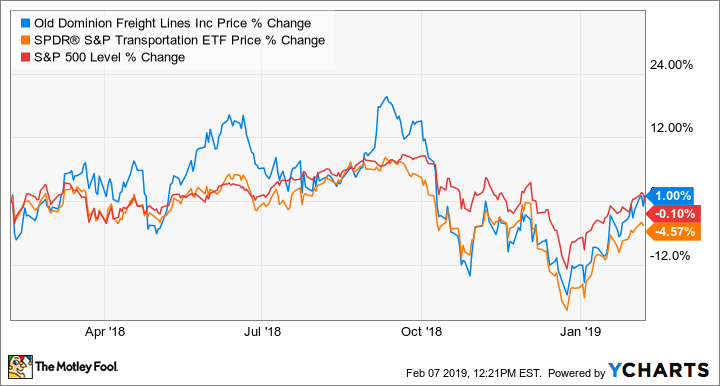Old Dominion Freight Line (ODFL -2.85%) has developed a nice habit of blowing by analyst expectations, and this quarter was no different. The company's fourth-quarter earnings result of $1.95 per share was well above analyst expectations thanks to another double-digit increase in revenue and the ability of management to keep costs in check.
Let's take a look at Old Dominion's most recent earnings report and what investors can expect in 2019.
Old Dominion Freight Line's results: The raw numbers
| Metric | Q4 2018 | Q3 2018 | Q4 2017 |
|---|---|---|---|
| Revenue | $1.02 billion | $1.06 billion | $891.1 million |
| Operating income | $218.9 million | $228.4 million | $143.4 million |
| Net income | $159.4 million | $173.4 million | $197.2 million |
| EPS (diluted) | $1.95 | $2.12 | $2.39 |
DATA SOURCE: OLD DOMINION FREIGHT LINE EARNINGS RELEASE. EPS = EARNINGS PER SHARE.
Old Dominion Freight's result doesn't look great on paper compared to the prior year, but that 18% decrease in earnings per share is largely attributed to a $104.9 million tax benefit from the changes in corporate tax rates. That was just an on-paper increase in earnings because it lowered its future tax liabilities. Absent this gain in 2017, earnings per share would have been $1.10.
What happened with Old Dominion Freight Line this quarter?
- As has been the case over the past few quarters, the company continues to post gains in every measurement of revenue and operating efficiency. Less-than-truckload (LTL) tons, shipments, and intercity miles were all up, and LTL revenue per hundredweight was up 12.9% to $22.24, which is the highest rate the company has posted this century.
- For the second quarter in a row, weight per shipment declined. Management said during the third quarter that lower weight per shipment is a deliberate operational change to reduce heavier-weighted shipments on its network.
- Even though employee headcount increased and costs were higher, revenue growth was faster such that the company's operating ratio for the quarter was at 78.7%. This was the first full year in Old Dominion's history that its operating ratio was below 80%.
- Management expects capital spending in 2019 to be about $490 million, which is down from the $588 million it spent in 2018.
- With the company's operating cash flow increasing significantly and the spending rate starting to level off, the board of directors approved a 30% increase in its dividend to $0.17 per share, or $0.68 per share on an annual basis. At today's stock price, that gives Old Dominion Freight Line's stock a dividend yield of 0.48%.

Image source: Getty Images.
What management had to say
In the company's press release, CEO Greg Gantt explained management's decision to cut weight per shipment and how that has impacted the bottom line:
The increase in our LTL tonnage included a 6.5% increase in LTL shipments that was partially offset by a 3.3% decrease in LTL weight per shipment. This decrease in LTL weight per shipment, which we expected, is consistent with the trend that we identified and explained earlier in 2018. Our LTL revenue per hundredweight benefited from the decrease in weight per shipment as well as the 1% increase in average length of haul, as the changes to each of these metrics generally result in an increased yield. The improvement in our revenue per hundredweight also reflects our continued focus on individual account profitability, which requires a consistent and long-term improvement in yield to offset our cost inflation while also supporting the continued investment in our business.
Looking forward
Old Dominion Freight Line has benefited from several tailwinds lately. Between the near decade long period of economic growth, a surge in logistics from e-commerce, and new rules on electronic logging devices for truck driver hours; the company has been in a position to grow revenue and capture market share from the full-truckload (FTL) industry.
The decision to slow down capital spending rates could be a sign that management expects growth to slow down a bit, but it's probably too early to read into that change because it could ramp up spending if it needs to add more capacity. There's no definitive way to tell whether economic growth will continue throughout 2019, but taking market share from the FTL shipping industry should give it plenty of room to grow no matter the economic situation over the next few years.





